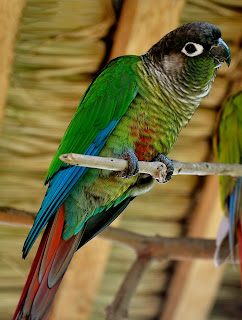GREEN-CHEEKED CONURE
(Pyrrhura Molinae)
credits to Wikipedia
The Green-Cheeked Conure is a popular bird to beginners in the parrot keeping hobby. It's small size, relatively quiet behavior and new mutations including a new Blue mutation developed in Europe has contributed to the Green-Cheeked Conure's popularity.
Habitat: Distributed in Argentina, Bolivia, the Mato Grosso regions in Brazil and Paraguay, this small parrot inhabits forests and forested woodlands, flocking in numbers of 10-20 individuals, even more if more food is available. Keep your parrot's cage furnished with various enrichment objects that require the bird to make use of both physical and mental qualities as this will help achieve the foraging and exploring skills your conure needs, as when deprived of such your bird will be prone to feather plucking.
Diet: Omnivorous. In the wild, these birds' main diet consist of plant matter, seeds and fruits. In captivity, a healthy mix should be provided to ensure your bird has enough of each nutrients to live a long, healthy life. Your bird's diet should consist of:
50% Vegetables like kale, broccoli, carrots and celery
20% Fruits like mango, papaya, apples and bananas
20% Commercial Parrot Pellets, Zupreme, Harrison's, Kaytee and Roudybush
7% Parrot Seed Mix
3% Nuts like peanuts, Brazil nuts, almonds and cashews
Cage size: A 20" x 20" x 22" should be the minimum cage size, longer is better. Ensure the cage bars aren't large enough for the parrot to escape or get stuck, and not too small for them not to be able to grip.
Aggression: This conure is somewhat bold, known to intimidate parrots and birds larger than itself. It is still relatively peaceful birds of the same size provided cage size is large enough to house both birds, two water dishes, two feeders, etc
Leave your comments, thoughts and experiences of this species below :)
Leave your comments, thoughts and experiences of this species below :)

No comments:
Post a Comment